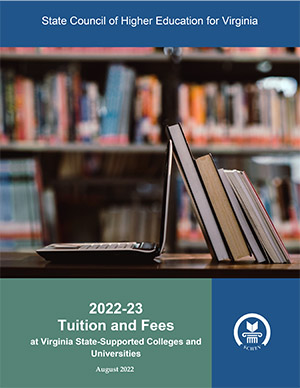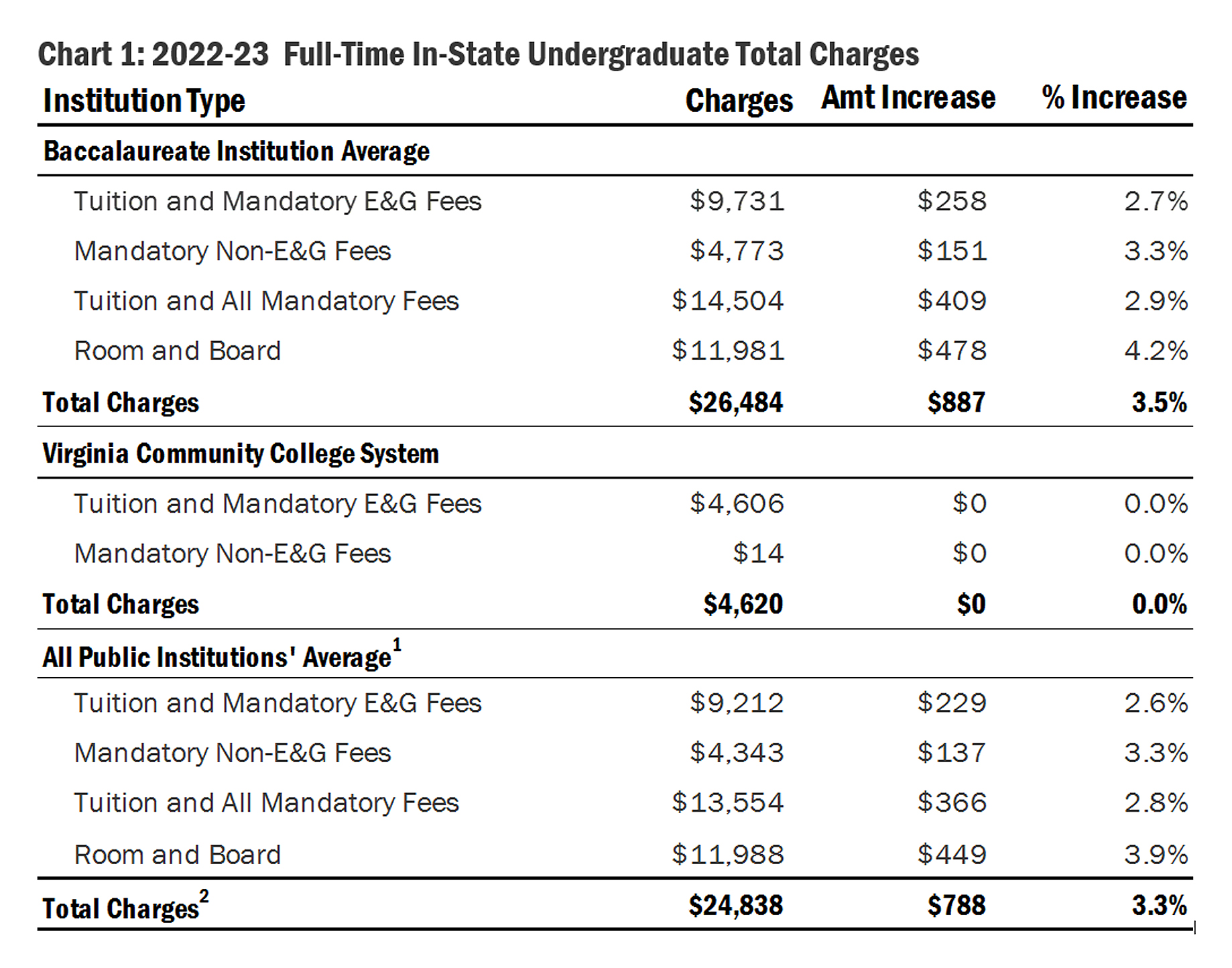Summary 
The Appropriation Act directs the State Council of Higher Education for Virginia (SCHEV) to submit an annual report to the Governor and the chairs of the House Appropriations and Senate Finance and Appropriations Committees documenting the annual change in total charges for tuition and fees approved by the boards of visitors at Virginia public institutions of higher education (Item 4-2.01.b.4.b). The following are key findings from the 2022-23 Tuition and Fees Report.
Read the full report

Tuition and mandatory educational and general (E&G) fees (those fees related to instruction and supported by the state) increased by
$229 (2.6%) for in-state undergraduate students at the system level. Four institutions (Norfolk State University, Virginia Military Institute, William & Mary and Virginia Community College System) did not increase tuition and mandatory E&G fees in 2022-23.

Mandatory non-educational and general (those fees related to non-instructional or “auxiliary” activities) increased by
$137 (3.3%).
 The average tuition and all mandatory fees for in-state undergraduates is $13,554, a $366 (2.8%) increase from the prior year.
The average tuition and all mandatory fees for in-state undergraduates is $13,554, a $366 (2.8%) increase from the prior year.

Room and board charges averaged
$11,981 at baccalaureate institutions, an increase of
$478 (4.2%).
 Total charges at baccalaureate institutions — the average sum of tuition, all mandatory fees and room and board — are $26,484 for the 2022-23 academic year, an increase of $887 (3.5%) for in-state undergraduate students.
Total charges at baccalaureate institutions — the average sum of tuition, all mandatory fees and room and board — are $26,484 for the 2022-23 academic year, an increase of $887 (3.5%) for in-state undergraduate students.

While charges have increased, Virginia undergraduate students on average will pay
46% of the costs related to education, while the state will provide
54%. This is a four-percentage point increase, in state support, as a result of increased state investment in higher education in the 2022-24 biennium. This percentage is still below Virginia’s cost-share policy of covering 67% of costs. SCHEV staff estimates that if the state funded institutions at the level of the cost-share policy (67%), tuition could be as much as
$2,700 (34%) lower than current levels.

The total charges for in-state undergraduates as a percentage of per-capita disposable income remains higher than the national average at
44.9%.
 Students who complete an associate degree at a community college and transfer to a baccalaureate institution can save an average of $20,065 of the cost of a bachelor’s degree.
Students who complete an associate degree at a community college and transfer to a baccalaureate institution can save an average of $20,065 of the cost of a bachelor’s degree.

While reported tuition and E&G fees increased, most institutions used one-time funding or deferred costs to hold these increases to zero for in-state undergraduate students in 2022-23.

Notes:
(1) Includes Richard Bland College -- a selective, residential, two-year college to prepare students for transfer to four-year colleges.
(2) Average charge for the majority of students at each institution, excluding tuition differentials..
The average tuition and all mandatory fees for in-state undergraduates is $13,554, a $366 (2.8%) increase from the prior year.
Total charges at baccalaureate institutions — the average sum of tuition, all mandatory fees and room and board — are $26,484 for the 2022-23 academic year, an increase of $887 (3.5%) for in-state undergraduate students.
Students who complete an associate degree at a community college and transfer to a baccalaureate institution can save an average of $20,065 of the cost of a bachelor’s degree.
